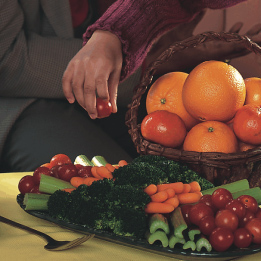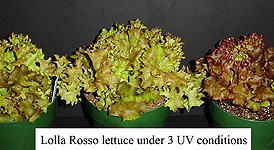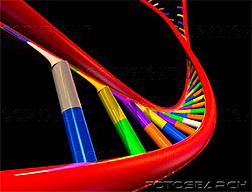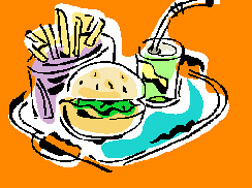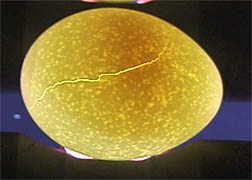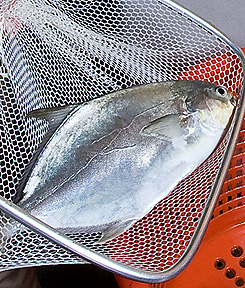| April 2009 |
Berry Compound Reduces Aging EffectAged laboratory animals that ate a diet rich in the berry and grape compound pterostilbene performed better in tests than those in a group that did not eat the enriched diet, according to the results of a new study by Agricultural Research Service (ARS) scientists. Pterostilbene reversed measurable negative effects of aging on brain function and behavioral performance. The results indicated that in aging rats, pterostilbene was effective in reversing cognitive decline, and that improved working memory was linked to pterostilbene levels in the hippocampus region of the brain. Scientific contact: James A. Joseph, (617) 556-3178, Jean Mayer USDA Human Nutrition Research Center on Aging, Boston, Mass. |
|
| Extreme Weather Boosts Antioxidant Levels in Soybean SeedsAgricultural Research Service (ARS) scientists have found that weather and climate play key roles in levels of a family of antioxidants tucked inside soybean seeds. Researchers analyzed the content of tocopherols in soybean seeds grown at several locations in Maryland between 1999 and 2002. Weather was relatively normal between 1999 and 2001, but extreme drought and warmer temperatures characterized 2002. There were small but significant increases in the proportion of alpha-tocopherol in beans from the same genetic line grown in warmer, full-season locations on Maryland's Eastern Shore, compared to beans that matured under slightly cooler conditions. But under extreme drought conditions in 2002, early maturing lines had as much as a 3.5-fold increase in relative alpha-tocopherol content, compared to the other years during which rainfall was adequate. Scientific contact: Steven J. Britz, (301) 504-6625 ext. 241, Food Components and Health Laboratory, ARS Henry A. Wallace Beltsville Agricultural Research Center, Beltsville, Md. |
Nanotechnology May be Used for Food SafetyA microscopic biological sensor that detects Salmonella bacteria in lab tests has been developed by an Agricultural Research Service (ARS) scientist and university colleagues. The sensor could be adapted to detect other foodborne pathogens as well. The sensor is part of an evolving science known as nanotechnology, the study and manipulation of materials on a molecular or even atomic level, measured in billionths of a meter, which is about 10 to 100 times thinner than a human hair. The biosensors include fluorescent organic dye particles attached to Salmonella antibodies. The antibodies hook onto Salmonella bacteria and the dye lights up like a beacon, making the bacteria easier to see. Scientific contact: Bosoon Park, (706) 546-3396, Quality and Safety Assessment Research Unit, ARS Richard B. Russell Research Center, Athens, Ga. |
|
| Nutrient Supports Bone Health Over TimeFindings from a new study funded by the Agricultural Research Service (ARS) suggest that natural plant pigments called carotenoids may help protect against bone loss in older men and women. Over the course of the four-year study, carotenoids were associated with some level of protection against losses in bone mineral density at the hip in men and at the lumbar spine in women. No significant associations were observed at other bone sites. The results suggest there is a protective effect of carotenoids, particularly of lycopene, against bone loss in older adults. The researchers concluded that carotenoids may explain, in part, the previously observed protective effects of fruit and vegetable consumption on bone mineral density. Scientific contact: Katherine Tucker, (617) 556-3351, Jean Mayer USDA Human Nutrition Research Center on Aging, Boston, Mass. |
Neutralizing Acidosis and Bone Loss among Mature AdultsA new study funded in part by the Agricultural Research Service (ARS) suggests that neutralizing an acid-producing diet may be an important key to reducing bone breakdown, or "turnover," while aging. The study comes on the heels of several ARS-reported studies suggesting that consuming more-than-recommended amounts of calcium may not be the main answer to protecting bone. A group of 78 volunteers had been provided either of two bicarbonates—potassium or sodium—along with their usual diet and exercise regimes. The bicarbonate groups consumed an amount of bicarbonate equivalent to about nine servings of fruits and vegetables daily. The results showed that the 78 volunteers in the bicarbonate groups had significant reductions in biomarkers that are associated with bone loss and fracture than the 84 in the no-bicarbonate group. Scientific contact: Bess Dawson-Hughes, (617) 556-3066, Jean Mayer USDA Human Nutrition Research Center on Aging, Boston, Mass. |
|
| Lettuce Carotenoids Affected by UV Light in GreenhouseGrowing the right type of green leaf lettuce during winter in a greenhouse—and exposing it to the right type of ultraviolet light—can boost levels of nutritionally beneficial carotenoids, according to an Agricultural Research Service (ARS) study. Supplemental ultraviolet-A light (UV-A) and ultraviolet-B light (UV-B) greatly increased the carotenoid and chlorophyll concentrations of the green leaf lettuce varieties, while slightly but significantly reducing the levels of those compounds in the red varieties. Interestingly, significantly higher levels of other phenolic phytochemicals were produced in the red leaf lettuce varieties, compared to the green leaf lettuce varieties under the same UV treatment conditions. Among the green leaf lettuce varieties, under identical light and growing conditions, "Concept" had about 10 times the level of lutein, a carotenoid, as "Black-Seeded Simpson." Also, the amount of lutein in two green varieties—"Marin" and "Waldmann's Dark Green"—more than doubled after receiving both supplemental UV-A and UV-B light, when compared to lettuce that received only regular light. Scientific contact: Steven J. Britz, (301) 504-6625, ext. 241, Food Components and Health Laboratory, ARS Henry A. Wallace Beltsville Agricultural Research Center, Beltsville, Md. |
Gene Variants Affecting Blood Fats IdentifiedA team of investigators at a research center funded by the Agricultural Research Service (ARS) has identified new genetic sites harboring common variations in DNA that are linked to imbalances in concentrations of blood lipids (fats). The findings provide another step forward in understanding the genetic contribution to dyslipidemia, a condition marked by overproduction of low-density lipoprotein (LDL "bad" cholesterol) and triglycerides, and underproduction of high-density lipoprotein (HDL "good"cholesterol). While each of the 30 genetic sites, called loci, identified conferred a modest effect individually, the analysis suggests that the more lipid-risk variants found in one individual, the higher his or her association with dyslipidemia. Together, the 30 sites explain a significant percentage of the genetic contribution to lipid levels among individuals. Scientific contact: Jose Ordovas, (617) 556-3102, Jean Mayer USDA Human Nutrition Research Center on Aging, Boston, Mass. |
|
| Food Choices and Health IndicatorsA study by Agricultural Research Service (ARS) nutritionist Rhonda Sebastian shows that among U.S. men and women aged 31 to 50, obtaining a greater proportion of total calories from conventional fast-food restaurants was associated with a higher BMI, or body mass index. Sebastian and colleagues analyzed the eating habits of more than 2,000 volunteers aged 19 to 50. The significant relationship between BMI and fast-food intake found among the 31- to 50-year age group was not found among the 894 volunteers who were in the 19- to 30-year age group. Scientific contact: Rhonda Sebastian, (301) 504-0343, ARS Beltsville Human Nutrition Research Center, Beltsville, Md. |
USDA Pressure Chamber Makes Egg Microcracks ShineA prototype pressure chamber and camera system that finds very small cracks, called microcracks, in fresh eggshells has been developed by Agricultural Research Service (ARS) scientists. The device could help the fresh egg industry find microcracks that can often go undetected during grading. The technology emulates human graders who squeeze eggs along suspected cracks to see if the cracks open. The camera then takes a picture before and while the crack is opening to "see" if the shell is cracked. The system detected 99.4 percent of eggshell cracks while recording almost no false positives (only 0.3 percent). In comparison, professional human graders had an 85.8 percent crack detection rate and 1.2 percent false positives. Scientific contact: Kurt C. Lawrence, (706) 546-3527, Quality and Safety Assessment Research Unit, ARS Richard B. Russell Research Center, Athens, Ga. |
|
| Futuristic Seafood: Raising Delicious Cobia and Pompano—Inland!An Agricultural Research Service (ARS) team including agricultural engineer Timothy J. Pfeiffer, fish nutritionist Martin A. Riche, and fish biologist Charles R. Weirich—all based in Ft. Pierce, Fla.—is determining how to best raise cobia and pompano inland, hundreds of miles from the nearest ocean or bay, in huge tanks of fresh or only slightly salty water. The tanks are part of what's known as a "recirculating aquaculture system," or "RAS," in which water is cleaned and used again and again. These systems offer the potential to reduce discharge of everyday fish-farm effluent to as little as 3 percent—or less—of the total amount of water used each day. Fish wastes and unused food collected in the system could be recycled as nutrient-rich compost. Scientific contact: Timothy J. Pfeiffer, (772) 465-2400, ext. 360, ARS Harry K. Dupree Stuttgart National Aquaculture Research Center, Fort. Pierce, Fla. |





